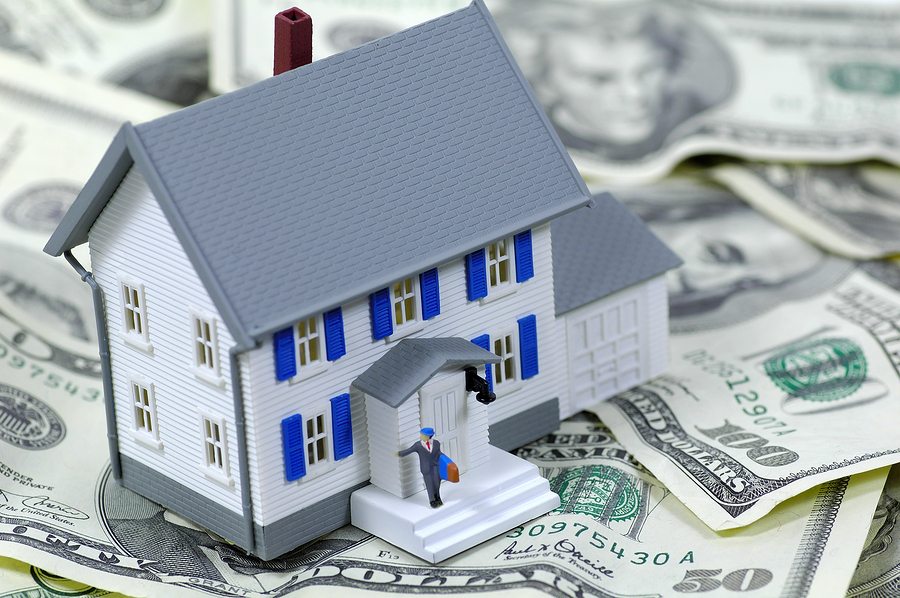by jeffp | Jan 11, 2016 | Inside Real Estate

For many people, a home is their biggest investment—and the mortgage that accompanies it their largest financial commitment. However, it may not be one they should eliminate—at least according to the experts. When the gurus wax poetic about eliminating debts, they are generally speaking of high-interest obligations such as credit cards with APRs around 13 percent, not 30-year mortgages with interest closer to 4 percent.
That said, in an uncertain economy, mortgage debt becomes more of a worry—especially if you’re nearing retirement or work in a volatile industry. Monthly payments of any size are always harder to make after you stop receiving paychecks. While the current residential mortgage delinquency rate of 5.35 is much lower than the peak of 11.27 in first quarter 2010, it’s still significantly higher than the 1.95 delinquency rate in fourth quarter 2006 before the last recession began.
So what’s the smartest move? Should you use every spare penny you can rustle up to pay down your mortgage balance or sock it away in savings and investments for retirement? It really depends on your personal financial situation.
Credit card debt is a burden
If your balances have crept up, and you’re making hefty payments on high-interest debt every month, it makes better financial sense to pay off your credit cards before you start chipping away at a bigger piece of your mortgage each month. Interest on credit card debt isn’t tax deductible; your mortgage interest is.
You have an IRA or 401(k)
Depending on the type of tax-favored retirement account you have, your contributions will result in a deduction on your current taxes or tax-free accumulated gains. Either way, it makes financial sense to put extra money towards your maximum retirement contribution before you begin paying down your mortgage at a faster pace.
You’re ready to retire
While it would be nice to be free of your mortgage payment before you collect your final paycheck, putting all your spare dollars into early payoff may leave you house-rich and cash-poor. You don’t want to find yourself in a situation where you’ve depleted your savings to the point where it’s difficult to cover necessities like food and fuel.
Once you’ve reduced your credit card debt and have maximized your tax-favored retirement account, there’s one more alternative use of your money to consider before prepaying your mortgage: market investments. Historically, stock-owning mutual funds with reinvested dividends have returned much higher earnings than the 4 percent you may be paying on your mortgage. Sock extra cash away there and you very well may come out ahead.
If you’d like to discuss the merits of paying off your mortgage further, consult your financial professional. And if your current home loan has an interest rate higher than 4 percent, contact your mortgage advisor to discuss your current refinancing options. A lower rate and a shorter term could help you become mortgage-free faster.
by jeffp | Dec 21, 2015 | Inside Real Estate

If you’re ready to purchase a new home — there are rules recently put in place to help protect you from entering into a risky mortgage. While these new rules may seem like obstacles placed in your way to prevent you from your homeowner dreams — and the lending process has certainly become more restrictive — these newer rules are there to help you purchase a home you can both enjoy and keep. If you’re not sure you’re ready to buy, consider these guidelines:
Ability to Repay
Adjustable-rate mortgages with super-low teaser rates were among the worst contributors to the foreclosure crisis, as were no doc loans that allowed borrowers to purchase homes without proving their income or savings. These products are a thing of the past—and likely to stay that way. Under the new “Ability to Repay” rule, mortgage lenders must thoroughly evaluate every consumer’s financial fitness regardless of the type of loan for which they are applying.
You can expect them to scrutinize your income and assets, your employment, your debts and your credit history as well as expected costs for homeowner’s insurance, mortgage insurance and property taxes when determining your ability to meet the monthly payment obligation on a loan. In most cases, your total monthly debt payments cannot exceed 43 percent of your monthly gross income or you’ll be denied financing approval.
Documentation of all details is required. This means more paperwork and longer processing times, especially if you’re self-employed as a freelancer or own your own business. You’re now required to produce two years of personal and business tax returns as well as a profit-and-loss statement and balance sheet to prove your repayment ability.
Qualified Mortgage
In the opinion of the Consumer Financial Protection Bureau, safer mortgages are ultimately more affordable. The “Qualified Mortgage” rule eliminates features they have deemed unsafe, such as terms longer than 30 years, interest-only payments and negatively amortizing loans—those in which minimum payments don’t cover the interest on the mortgage, causing the balance to continue to grow.
Additionally, the rule prohibits lenders from charging upfront fees of more than 3 percent of the mortgage balance. These fees include title insurance, origination fees and points. Points are pre-paid interest, each equal to 1 percent of the loan amount, used to lower the interest rate on the mortgage.
Unqualified Loans
Lenders can still choose to offer mortgage products that do not follow these rules. However, because they will be considered unqualified loans, they cannot be sold to Fannie Mae or Freddie Mac, the two government-sponsored enterprises that buy about 70 percent of all mortgages from lenders on the secondary market. This means it is likely that few lenders will bother. If they do, consumers can expect to pay much higher fees and interest rates for the products offered.
If you’re ready buy and have questions, contact your real estate professional for further insight.
by jeffp | Dec 21, 2015 | Inside Real Estate
If you’re ready to purchase a new home — there are rules recently put in place to help protect you from entering into a risky mortgage. While these new rules may seem like obstacles placed in your way to prevent you from your homeowner dreams — and the lending process has certainly become more restrictive — these newer rules are there to help you purchase a home you can both enjoy and keep. If you’re not sure you’re ready to buy, consider these guidelines:
Ability to Repay
Adjustable-rate mortgages with super-low teaser rates were among the worst contributors to the foreclosure crisis, as were no doc loans that allowed borrowers to purchase homes without proving their income or savings. These products are a thing of the past—and likely to stay that way. Under the new “Ability to Repay” rule, mortgage lenders must thoroughly evaluate every consumer’s financial fitness regardless of the type of loan for which they are applying.
You can expect them to scrutinize your income and assets, your employment, your debts and your credit history as well as expected costs for homeowner’s insurance, mortgage insurance and property taxes when determining your ability to meet the monthly payment obligation on a loan. In most cases, your total monthly debt payments cannot exceed 43 percent of your monthly gross income or you’ll be denied financing approval.
Documentation of all details is required. This means more paperwork and longer processing times, especially if you’re self-employed as a freelancer or own your own business. You’re now required to produce two years of personal and business tax returns as well as a profit-and-loss statement and balance sheet to prove your repayment ability.
Qualified Mortgage
In the opinion of the Consumer Financial Protection Bureau, safer mortgages are ultimately more affordable. The “Qualified Mortgage” rule eliminates features they have deemed unsafe, such as terms longer than 30 years, interest-only payments and negatively amortizing loans—those in which minimum payments don’t cover the interest on the mortgage, causing the balance to continue to grow.
Additionally, the rule prohibits lenders from charging upfront fees of more than 3 percent of the mortgage balance. These fees include title insurance, origination fees and points. Points are pre-paid interest, each equal to 1 percent of the loan amount, used to lower the interest rate on the mortgage.
Unqualified Loans
Lenders can still choose to offer mortgage products that do not follow these rules. However, because they will be considered unqualified loans, they cannot be sold to Fannie Mae or Freddie Mac, the two government-sponsored enterprises that buy about 70 percent of all mortgages from lenders on the secondary market. This means it is likely that few lenders will bother. If they do, consumers can expect to pay much higher fees and interest rates for the products offered.
If you’re ready buy and have questions, contact your real estate professional for further insight.
by jeffp | Dec 7, 2015 | Inside Real Estate

Despite the advantages of a seller’s market, it never hurts to take proactive measures to ensure your home sells for the best price and as quickly as possible. Consider the following suggestions to position your property favorably in 2016.
- Exceed buyer’s expectations. Many people who’ve been around the real estate block expect pre-owned homes to come with problems. Get your property into tip-top shape before you put it on the market and you’ll eliminate most buyers’ potential objections. Doing so will require fixing anything that does not work, touching up paint (or repainting altogether) and thoroughly cleaning or replacing any carpets. You may also need to update your landscaping and repaint the exterior of your home. It sounds like a lot of work—and it some cases it may be—but selling your property at asking price is worth it.
- Don’t price your home without a comparative market analysis. You may think your property is worth $500,000, but the local real estate market needs to agree with that price if you want to have any chance of making a successful sale. Ask your real estate professional to provide you with a comparative market analysis (also known as a CMA) showing how your property stacks up against similar recently sold homes. This analysis will also help you understand what it will take to sell in your neighborhood. For example, if you live in an area with a number of foreclosures, you might need to lower your asking price.
- Don’t wait for values to go higher before you put your home on the market. According to the National Association of Realtors® (NAR), new home construction is lagging behind job growth in nearly two-thirds of metro areas in the U.S. Additionally, there are more buyers considering the housing market, as a result of continued improvements in the job sector and broader economy.However, that doesn’t mean you should wait. While it is true prices could continue to increase, waiting to sell carries significant risks that may not be worth your while for the potential of a better price. If you’re ready to sell, then jumping in with a competitive price can also lead to more offers and a potentially higher sold price for your home.
If you’d like to discuss the current real estate market in your area or evaluate options for selling your home in 2016, your real estate professional can provide valuable insight and advice.
by jeffp | Nov 19, 2015 | Inside Real Estate

In most cases, the home is the largest asset a person has. Whether the real estate market is good or bad, it’s important to remain apprised about your asset and surrounding properties that can impact the value of your asset.
The property tax rate appeal process is one way to stay informed. It should be done anytime a reassessment happens and you feel there’s a discrepancy in tax figures, not just when the real estate market is down. A successful appeal can save you hundreds to thousands of dollars if the local government doesn’t simultaneously raise taxation rates and counteract your tax savings from winning the appeal .
However, it’s up to you to do the research during every assessment period. Basically, the appeal process involves searching for any discrepancy in the how the taxation board comes up with the amount you’re to pay in taxes and noting nearby comparable properties paying less than you in taxes. Most appeal experts recommend having at least five credible comparable property examples in the appeal.
The biggest question is whether or not you should undertake the appeal process on your own? You most certainly can, and some appeal boards might even be more favorable to appeals filed by an individual. However, you do have the option for help if you need it. You can usually always find a local lawyer, real estate agent, or financial consultant with expertise in appealing, but these entities often charge a fee of up to 50% of the first annual reduction.
The first step in appealing is obtaining the necessary forms off the internet or at your local tax assessor office. The tax assessor office is also where you’ll find the comparable property values in your area.
Here are some key tips to help you during the process:
1. Recalculating – property taxes are derived from a percentage of the property value multiplied by whatever the local tax rate is. Recalculate your tax bill, making sure that the property description is correct. It’s often the basics that are wrong. So, carefully check the accuracy of key features like the number of baths and rooms.
2. Renovation – a renovation might increase the home’s market value and tax valuation. However, certain renovations and additions that aren’t habitable all year long might provide a loophole since they aren’t considered a full-time new space.
3. Circumstances – you might have an argument for a lower home valuation if you can prove certain circumstances. For example, a nearby road project causing a nuisance, a roof leak that you’re unable to afford repairing, or damaged windows in need of repair.
4. Deadlines – be aware that there’s usually an appeal deadline. It’s usually posted in the real estate section of local newspapers.
5. Preparation – if you’re presenting the appeal yourself, then you might consider looking at previous newspaper reports or documents discussing the appeal process. The tax assessor’s office may be able to offer some helpful advise, but do organize your questions before arriving, as they are often very busy during the tax and appeal season. Once you’ve compiled all the information, it may be helpful to rehearse your final presentation several times and readjust for any flaws or inconsistencies.
6. Help – if you need it, get it. Remember to check the fees and credibility of the firm before signing on the dotted line.
7. Quitting – hang in there, it might be a tedious process, but remember the payout that will come from eliminating any existing inequality of taxation.
by jeffp | Nov 5, 2015 | Inside Real Estate

With Autumn in full drive, we’re donning warmer clothing and thinking about the holidays. We might also be thinking about higher energy bills. While The U. S. Department of Energy advises homeowners to regularly conduct home energy audits to assess how much energy your home uses, now it the time to decide on the steps you can take to make it more efficient before winter arrives. An energy audit will help you determine where your house is losing energy and evaluate the efficiency of your home’s heating and cooling systems. Problems that are uncovered during an audit, when corrected, can save you significant amounts of money over time.
You can easily perform a home energy audit by walking through your home and conducting a careful inspection. As you go though each area, keep a checklist of the problems you found. This list will help you prioritize what upgrades you need to make.The list below contains the Department of Energy’s recommendations for conducting your audit:
Air leaks – Make a list of the places there are obvious drafts. Check for gaps along the baseboard or edge of the flooring and at junctures of the walls and ceiling. Also look for gaps around pipes and wires, electrical outlets, foundation seals, and mail slots. Check to see if the caulking and weather stripping are applied properly, leaving no gaps or cracks, and are in good condition.
Inspect windows and doors for air leaks. See if you can rattle them, since movement means possible air leaks. Check the storm windows for proper fit.
Insulation – Check the attic hatch to see if it is at least as heavily insulated as the attic, is weather stripped, and closes tightly. In the attic, determine whether openings for items such as pipes, ductwork, and chimneys are sealed. Check to see if there is a vapor barrier under the attic insulation. The vapor barrier might be tarpaper, or a plastic sheet. If there does not appear to be a vapor barrier, you might consider painting the interior ceilings with vapor barrier paint to reduce the amount of water vapor that can pass through the ceiling. Make sure that the attic vents are not blocked by insulation. You also should seal any electrical boxes in the ceiling with flexible caulk (from the living room side or attic side) and cover the entire attic floor with at least the current recommended amount of insulation.
Check the walls’ insulation by selecting an exterior wall and turning off the circuit breaker or unscrewing the fuse for any outlets in the wall. Once you have determined that your outlets are not getting any electricity, remove the cover plate from one of the outlets and gently probe into the wall with a thin, long stick or screwdriver. If you encounter a slight resistance, you have some insulation there.
If your basement is unheated, determine whether there is insulation under the living area flooring. In most areas of the country, an R-value of 25 is the recommended minimum level of insulation. An R-value indicates insulation’s resistance to heat flow. The higher the R-value, the more effective the insulation.
The insulation at the top of the foundation wall and first floor perimeter should have an R-value of 19 or greater. If the basement is heated, the foundation walls should be insulated to at least R-19. Your water heater, hot water pipes, and furnace ducts should all be insulated.
Heating/Cooling Equipment – If you have a forced-air furnace, check your filters regularly and replace as needed. Generally, you should change them about once every month or two, especially during periods of high usage. Have a professional check and clean your equipment once a year.
Check your ductwork for dirt streaks, especially near seams. These indicate air leaks, and they should be sealed with duct mastic, a non-toxic adhesive-sealant. Insulate any ducts or pipes that travel through unheated spaces. An insulation R-Value of 6 is the recommended minimum.
Lighting – Examine the wattage size of the light bulbs in your house. You may have 100-watt (or larger) bulbs where 60 or 75 watts would do. You should also consider compact fluorescent lamps for areas where lights are on for hours at a time.








